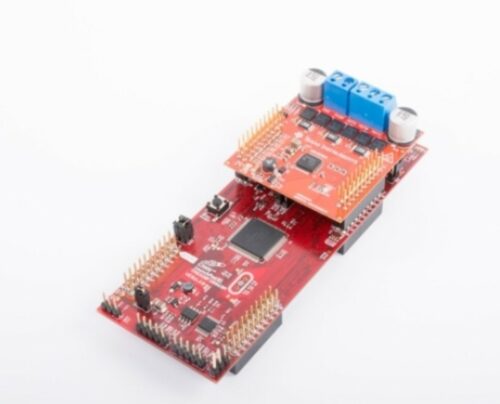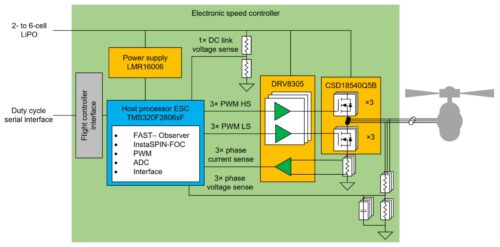A specialized high-speed reference design is available for Electronic Speed Controller (ESC) modules specifically designed for drones or unmanned aerial vehicles (UAVs).

Electronic Speed Controller (ESC) modules are crucial for civilian drones and those seeking advanced models that deliver improved efficiency, longer flight durations, and greater dynamic capabilities with smoother and more stable performance. Texas Instruments (TI) has launched ESC reference designs for drones or unmanned aerial vehicles (UAV). The sensorless speed control system has been tested up to 1.2-kHz electrical frequency using Field-Oriented Control (FOC) speed control. This high-speed reference design for drone ESCs features the best FOC algorithm implementation, resulting in longer flight times, improved dynamic performance, higher integration, a smaller board size, and fewer Bill of Materials (BOM) components. The reference design enables top dynamic performance with sensorless FOC, and it has been tested at 12,000 RPM using 3 LiPo cells. The design suits various applications such as drones and UAVs, high-speed motors, battery-operated power tools, etc. When examining a drone, the module definitions are commonly employed to describe the various subsystems necessary for constructing the complete drone flight system.
The reference design is based on the TMS320F28069F microcontroller unit (MCU) equipped with a control law accelerator (CLA) and integrated control peripherals in low pin-count devices. The MCU is used to provide the motor control platform. A gate driver IC DRV8305 is used in the design for 3-phase motor drive applications, offering three high-precision half-bridge drivers that can operate a high-side and low-side N-channel metal-oxide-semiconductor field-effect transistor (MOSFET) and are temperature compensated. The Pulse-width modulation (PWM) DC/DC buck regulator used in the design has a wide input range of 4 to 60 V, making it suitable for various industrial and automotive power conditioning applications. A power MOSFET is used in the design to minimize losses in power conversion applications.

The drone ESC reference design features a high dynamic performance of up to 1 kRPM to 10 kRPM speed in less than 0.2 seconds and an electrical frequency of 100 Hz to 1 kHz. The design is equipped with fast speed reversal capability for roll movement and higher PWM switching frequency. The drone ESC can operate with input voltage ranging from 4.4 to 45 V, supporting two to six or more LiPo battery cells. The reference design estimates motor temperature by monitoring changes in winding resistance. The high PWM frequency of around 45 to 60 kHz is typical in current designs of the drone ESC due to the low time constant of the motor and frequency-dependent sensors, with a trend towards even higher frequencies. In addition, communication with the flight controller is necessary, which can be achieved through duty cycle or serial communication. The algorithm used in the ESC controller incorporates a back-EMF (electromotive force) based angle estimator, enabling customers to focus solely on the FOC algorithm during the motor control design phase.
This reference design has been tested by TI. It comes with BOM, schematics, etc. You can find additional data about the reference design on the company’s website. To read more about this reference design, click here.




